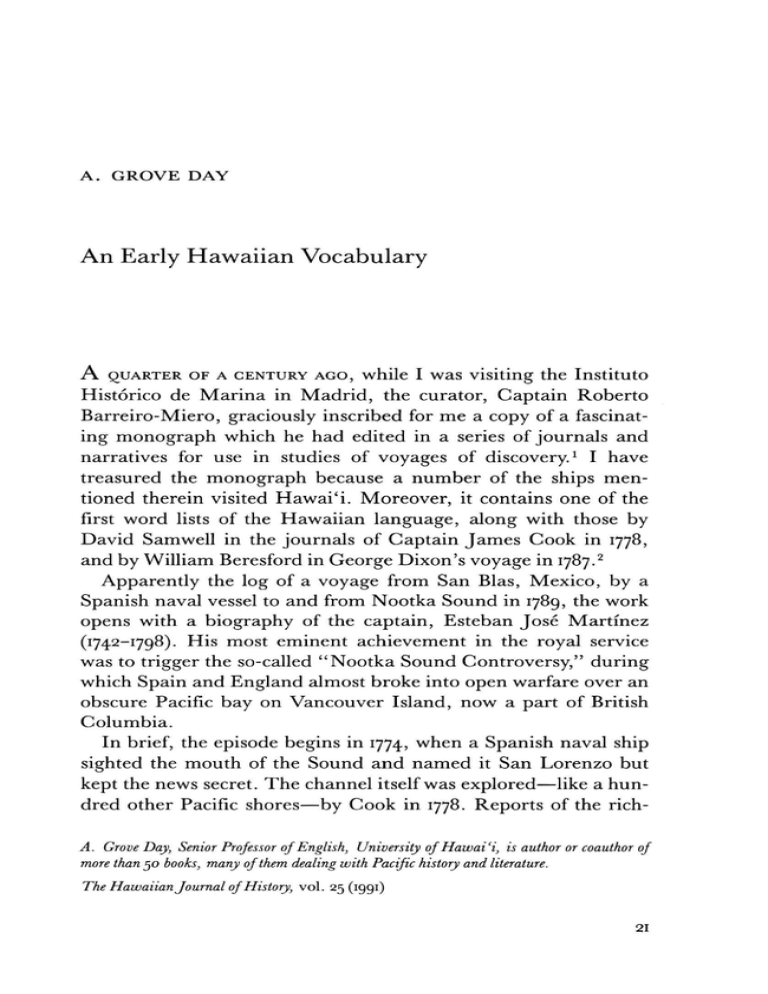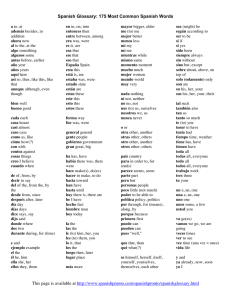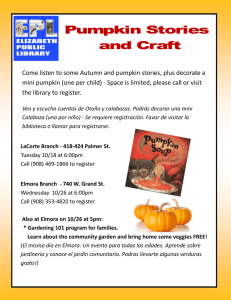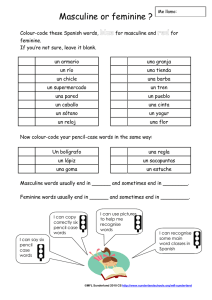An Early Hawaiian Vocabulary
Anuncio

A. GROVE DAY An Early Hawaiian Vocabulary A QUARTER OF A CENTURY AGO, while I was visiting the Institute) Historico de Marina in Madrid, the curator, Captain Roberto Barreiro-Miero, graciously inscribed for me a copy of a fascinating monograph which he had edited in a series of journals and narratives for use in studies of voyages of discovery.1 I have treasured the monograph because a number of the ships mentioned therein visited Hawai'i. Moreover, it contains one of the first word lists of the Hawaiian language, along with those by David Samwell in the journals of Captain James Cook in 1778, and by William Beresford in George Dixon's voyage in 1787.2 Apparently the log of a voyage from San Bias, Mexico, by a Spanish naval vessel to and from Nootka Sound in 1789, the work opens with a biography of the captain, Esteban Jose Martinez (1742-1798). His most eminent achievement in the royal service was to trigger the so-called "Nootka Sound Controversy," during which Spain and England almost broke into open warfare over an obscure Pacific bay on Vancouver Island, now a part of British Columbia. In brief, the episode begins in 1774, when a Spanish naval ship sighted the mouth of the Sound and named it San Lorenzo but kept the news secret. The channel itself was explored—like a hundred other Pacific shores—by Cook in 1778. Reports of the richA. Grove Day, Senior Professor of English, University of Hawai'i, is author or coauthor of more than 50 books, many of them dealing with Pacific history and literature. The Hawaiian Journal of History, vol. 25(1991) 21 22 THE HAWAIIAN JOURNAL OF HISTORY ness of the furs traded by the tribe ashore—especially those of the sea otter, in high demand in China—aroused various Europeans to send ships to that coast, and some sort of trading post was set up ashore by British John Meares in 1778. The following year, seizure by two Spanish naval ships of several trading vessels aroused a violent international dispute over possession of the area. The decision of the "Nootka Sound Convention" in 1790 in favor of British claims explains why Canada never became a part of the powerful Spanish empire. For five years more, however, the Sound continued to be a magnet for traders from four nations; both Russia and the United States added their quota to the fur seekers of the Sound.3 The Hawaiian-Spanish vocabulary, contained in the log, was written just two centuries ago and some 30 years before the translations of the celebrated exile 'Opukaha'ia in Connecticut. In his Memoirs, the young seeker of foreign knowledge mentions that he was preparing a grammar, a dictionary, and a spelling book, as well as translating into Hawaiian the entire Book of Genesis. Only the grammar has survived.4 Overlooked by the makers of our outstanding English-Hawaiian dictionaries of today, the vocabulary made on the return voyage of the naval ship Princesa from Nootka is a fascinating revelation of many usages heard long before New England missionaries grappled with the problems of putting in black and white the melodious speech of the unlettered Polynesian nation. Reading the preface by Captain Barreiro, one learns that, fearing a collision between Spanish claims to the American coast and the expansion of the Russian empire south from Alaska, the viceroy of New Spain (Mexico) ordered that a ship be sent north of Monterey to protect these claims. Under the command of Juan Perez, the Santiago sighted the mouth of Nootka Sound. Aboard the ship as second pilot was Esteban Jose Martinez. He it was who became the prime mover in the creation of the early word list. Little is known of the life of Martinez previous to 1773 or later than 1795. Probably a native of Seville, he learned the art of navigation at the Real Colegio de San Telmo in that city and began making various voyages to the Americas. From San Bias he voy- AN EARLY HAWAIIAN VOCABULARY 23 aged almost annually northward and advanced in rank in the Navy. Twice he served as commandant of that busy port, and twice he headed important expeditions. During the first of these expeditions, when he was in command of the frigate Princesa and her consort San Carlos, for the first time a Spanish ship from Mexico encountered a Russian ship off the American coast. Alarmed by evidences of settlement by the czar's empire, on his return to port Martinez recommended that he head another expedition with the main purpose of forestalling rivalry by taking possession of Nootka Sound. Armed with royal documents, in command of the same two ships, Martinez departed from San Bias on February 19, 1789, and arrived in the sound early in May. There, during six months, he set up a fort, made friends with the local chief Maquinna, planted a garden, compiled a vocabulary of the Nootka Indians, 5 and executed his orders to take control of all shipping in the region. As a result of his actions, this officer was to find himself in a wasp's nest from which he emerged with vilification and the charge that he brought Spain and England to the verge of outright warfare. The Spanish captain found that two American ships, which had spent the winter in the Sound, were still in the neighborhood. Moreover, they were soon joined by several British vessels sent to the Pacific by a company in which John Meares was most active. These comprised the Iphigenia under William Douglas; Princess Royal under Thomas Hudson; Argonaut under James Colnett; and North West America under Robert Funter. Martinez decided to leave the American ships alone, despite his instructions, and during his stay he allowed the Iphigenia and Argonaut to depart as well. When the latter decided to return, she was captured. The North West America was confiscated, given a Spanish name, and sent to explore the coast to the south. Ordered to return to San Bias, Martinez sailed from the Sound on October 31 without waiting for the San Carlos. The Princesa, without support, herded as prisoners the captains and crews of the Princess Royal, the Argonaut, and a small American vessel, the Fair American, which had arrived in October under the command of teenaged Thomas Humphrey Metcalfe.6 At San Bias the international trouble began. By nature, Martinez did not deserve the obloquy heaped on 24 THE HAWAIIAN JOURNAL OF HISTORY him by the British; some of the rival captains, like James Colnett, were more violent and meretricious than anyone could imagine. The two priests who accompanied the expedition had only good words for their captain. He was a scholarly type and wrote on September 30 a lengthy description of the Nootka region, its inhabitants, and products, and, anticipating his Hawaiian-Spanish vocabulary, even compiled a considerable similar word list of the Nootka Indian language. He believed that the "Sandwich Islands" had first been discovered by ships under the Spanish flag, and he later pointed out the value of the central location of the Hawaiian group and their utility in providing not only support for 400,000 inhabitants, but supplies for visiting ships such as those from Nootka.7 The captain's collaborator on the vocabulary during the return voyage was a Hawaiian sailor taken as a prisoner off James Colnett's Argonaut. He, too, was devout. On September 13, objecting that on this day of Holy Mary two youngsters were being baptized, whereas he was still called by his native name of Matutaray, he begged that he be named "Maria." This he did because he had once been cured of an ailment by praying to the Virgin. The two priests aboard compromised by naming him Jose Mariano. Here was the sort of captured sailor who, far from his home islands, was to become the verbal informant for the Hawaiian-Spanish vocabulary that begins on the next page. To the list of words, the collaborators added the numbers from 1 to 30. In addition, Mariano offered information of the current chiefs of his islands. "Tayana" (Ka'iana) was named as the principal chief of the island of Hawai'i. 8 "Temejameja" (Kamehameha) and "Teomouri" (Keawemahili?) were supposed to be brothers of Ka'iana and fellow chiefs of the same island. "Tayo" (Kaeo) was king of the island of "Atoay" (Kaua'i), and his brother "Jetiri" (Kahekili) was king of five small islands. To the list, headed "Vocabulary of the language of the natives of the islands of Sandwich, translated into Castilian," Martinez adds an interesting note that may be worded as follows: This vocabulary comes from the Indian [Hawaiian] whom I have on board named Jose Mariano (alias) Matutaray. It is apparent in AN EARLY HAWAIIAN VOCABULARY 25 him that the natives of those islands use very few letters of the alphabet. His pronunciation is facile and they have many terms comparable to those of the language of the islands of Tahiti. . . . They do not trill the r nor use the 1, nor many other letters of the ABC. Spanish and Hawaiian indeed resemble each other in pronunciation and are smooth and melodious tongues. Vowels in both are pronounced as in Latin. The vocabulary shows that before the adoption of a standard alphabet by missionary printers, the South Pacific use of / in place of the current k and the use of r for / was more common. Since h in Spanish is silent, that sound would be replaced by Martinez with/ Remembering that the only constant in language studies is S A N D W I C H Aru aru . . . . Y 6 Toto Omoti Tepo Raobojo . . . . Jeray Tuamata . . . . Riji-rigi . . . . Onojo Jeyju Paparina . . . . Popoyao . . . . Reje-reje . . . . Guaja Nijo Jetui Jerero Aguay Humi-humi . • • Mamatani . . . . Matuagine . . . . Majana Mopuna Tayta-hinu . . . Taytu-hana . . . Jejatu Jera Jereputa . . . . Jeratomo . . . . Marcemarrma . . Ajiaje Poere Yneginey . . . . C A S T E L L A N 0 S AN O W ICII Cuerpo. Carne. Sangre. Sombrero. Cabeza. Cabello o pelo. Frente. Cejas. Pestanas. Ojos. Narices. Carrillo. Orejas. Labios. Boca. Dientes. Muelas. Lengua. Barba. Las barbas del hombre. Padre. Madre. Hijo. Hija. Hermano. Hermana. Las estrellas. El sol. El sol sale. El sol se pone. Dia. La noche. Noche oscura. Ayer. Ano Abobo Yuta Jetay Pupuji Matani Puay Pojive Rima-rima . . . Tue-tue Peaji Taguarima . . . Jatua Nimanuy . . . . Pirimay Gua hina . . . . Turoto Rimayti Mayao Huma-huma . . . Tuomo Opii Huja Turi-turi . . . . Oro-oro Tapuay Taguamo . . . . Tanata Guajine Heremature . . . Ruagine Tahiti Tahitimajine . . Papanojo . . . . C A S T E L L A N O Hoy. Mafiana. Tierra. La mar. El fuego. El viento. El pescuezo. Los hombros. Los brazos. Los codos. Las manos. La palma de dicha. El reves de dicha. Dedo pulgar. El dedo indice. El dedo de enmedio. El dedo del anillo. El dedo pequeno. Las unas. El pecho. La espalda. La barriga. Los muslos. Las rodillas. La pierna. El pie. Los dedos del pie. Hombre. Mujer. Viejo. Vieja. Muchacho. Muchacha. Silla. CASTELLANO SANDWICH Ypu Jamama . . . Lepo Onetea Ypututuy . . . Tutuy Jeagi Upa Tuy Ajo Totoy Mejana Aguajia . . . Jeuguaji . . . Poay Jo-uhire Ju-ay Papani Teateo Jurumano . . . Tuono Jepa Oti-oti Caja o baul. Tintero. Salvadera. Arenilla. . Un candelero. Una vela. La luz de una vela. Unas tijeras. Una aguja. Hilo. Frio. Calor. . Caliente. . El humo. Una Have. Una cerradura. Abre. Cierra. Papel. . Una pluma. Una olla. Un plato o cazuela. Una sierra de carpintero. Jonoy Un escoplo. Toyti-pi Un cepillo. Amana Un martillo. Juo-ay Un bule. Magina La luna. Joata Magina . . La luna sale. Tutagi Magina . La luna se pone. Titoo Arco. Pana Flecha. Rere Disparar la flecha. Pajo Lanza. Pajoa Cucliillo. Paji Navaja. O-oti Cortar. O-o Matar o herir. Jepu Fusil o escopeta. Onepaju . . . . Polvora. Pojatu Bala. Tahura Cordel o cuerda. Majiori Morrion de pluma. Ujimay Manto de pluma. Aju-ura Esclavina de pluma. Tuy-tuy Dar de golpes. Memeri Una cancion. Jura Danza o baile. Jatiri Trueno. Jeu-hira Relampago. Jare Casa. Piritea Cama. Papanani . . . . Mesa. Ti-ji Banco. Nene Pato. Jemanu Un palomo. Maya Platanos. Tanu Banana. . SANDWICH CASTELLANO Jeuji Name. Uru Rima. Jeto Cafia dulce. Tamau El melon. Taro La sandia. Nio Cocos. U-ara Papas. Aba Cualquier licor. Tautaji Una canoa. Joe El canalete. Tiapea Un palo de canoa. Motu Una embarcacion. Oputete La vela de navio. Tajuri Zozobrar. Jemo o Una culebra. Gu-ajie Madera en general. Pojatu Una piedra. Moena Un petate cualquiera. Pepeji Un muerto. Jo-ite-ita . . . . Dejame ver. Aruri Mira. Nana Lo veo. Aureyti No lo veo. Taray Un liacha. Mii Un frasco. Ju-e-ja-ore . . . Una limeta. Anapa Un vaso. Tejau Nubes. Je-o-ju Nieve. Je-u-a Llover. Jeguay Agua dulce. Guaytaji . . . . Cualquier rio. Jeya Pescado en general. Matao Un anzuelo. Upena Una red de pescar. Jejou Un clavo de fierro. Jeu-jay Una puerta. Yputa Ventana. Ay Comer. Ynu Beber. Pua Un puerco. Moa El gallo. Tinana La gallina. Jejua Un huevo. Yrio Un pcrro. Yriofine Una perra. Tuy Que haces. Jana Trabajar. Tefora Ballena. Aru-aru Barba de ballena. Ata Reir. Ninau Como se llama esto. Manaro Dame mas. Nuy nuy Mucho. Yti-yti Poco. O-au Tu. 0-oe Yo. Aroja Amigo. Maytay Bueno. SANDWICH CASTELLANO SANDWICH CASTELLANO Puni-puni . . . . Juna Tuji Tataja Jinu-jinu . . . . Jajao Je-aa Tuagivi Ra-au Moe Rague Joaguy Nana Manu Mao Mane Joroy Jeri Jorono Joy-may Jeripera Pimay Jerenone . . . . Joro Tutuni Tuamaja Mama Jepu Joy-joy Tiora Jajao Uji U-eje Tu-u Nojo Malo. Ladron. Una regla de delinear. Tirar una linea. Un farol para la luz. Una bolsa. Un panuelo. Montes. Arboles. Donnir. Toma esto. Vuelvemelo. A donde. Pajaros en general. De este lado. Del otro lado. Lavar. Un jefe o capitan. Oye. No te vayas. Anda vete. Ven aca. Anda. Apriesa. Corre. Pesado. Ligero. Agarra. Larga. Tiralo. Rompelo. Pontelo. Quitatelo. Levantate. Sientate. Nonoy Nonoy-ay . . . . Jey ri Joni Nanajo Otomo O-ata Mamay Eati Tatau Erenure Nanupata . . . . Aje Aori Tereague . . . . Toymeti Rapa-rapa . . . . Pau A-oreyte Pupu Poctore Roro-giri . . . . Nani Yna-yna Tagea Gueri-gueri . . . Jininay Ani-ani Tau-u-hira . . . Ata-ata Onena-nena . . . Uri-uri Omao-mao . . . Ura-ura Ere-ere Dame. Dame que comer. Un huevo. Oler u olor. Morder. El anillo del dedo. Una concha cualquiera. Un dolor. Enfermo. Escribir. Una mosca. Un mosquito. Si. No. Cobre. Fierro. Plata o metal bianco. Yo no tengo. No te entiendo. Abalorios. Pequeno. Grande. Bonito o precioso. Corajudo o enfadado. Habla. Calla. Acostarse. Un espejo. Un baston dc mano. Blanco. Verde. Azul. Amarillo. Encarnado. Negro. MODO QUE TIENEN DICHOS NATURALES DE CONTAR Ataji Arua Atom Aja Arima Aono Ajitu Arite Ay-ua Humi Tumamataji Tumamarua Tumamatoru Tumamaja Tumamarima Uno. Dos. Trcs. Cuatro. Cinco. Seis. Siete. Ocho. Nueve. Diez. Once. Doce. Trece. Catorce. Quince. Tumarriaono Tumamajitu Tumamarite Tumamay-ua Tumama humi . . . . Tanataji Tanarua Tanatoru Tanaja Tanarima Tanaono Tanajitu Tatiarite Tanayua Tana-humi Dieciseis. Diecisiete. Dieciocho. Diecinueve. Veinte. Veintiuno. Veintidos. Veintitres. Veinticuatro. Veinticinco. Veintiseis. Veintisiete. Yeintiocho. Veintinueve. Treinta. 28 THE HAWAIIAN JOURNAL OF HISTORY change, it is amazing that most of the words in the Martinez vocabulary closely resemble their transliterations in the standard dictionaries of today. 9 Take, for example, the following from the first vocabulary column: Aru aru [alu'alu] body [skin] Y 6 [To] flesh Toto [koko] blood Tepo [ka po'o] the head Raobojo [lauoho] head of hair or hair Jeray [ka lae] the forehead Tuamata [ku'emaka] eyebrows Riji-rigi [lihilihi] eyelashes Onojo ['onohi] eyes Jeyju [ihu] nostrils [nose] Paparina [papalina] cheek Popoyao [pepeiao] ears Reje-reje [lehelehe] lips Guaja [waha] mouth Nijo [niho] teeth Jetui [ke ku'i] the molars Jerero [elelo] tongue Humi-humi ['umi'umi] beard Mamatani [makua kane] father Matuagine [makuahine] mother Mopuna [mo'opuna] daughter [grandchild] Tayta-hinu [kaikua'ana] brother Tayta-hana [kaikuahine] sister Jejatu [ke hoku] the stars Jera [ka la] the sun Poere [po'ele] dark night Yneginey [inehinei] yesterday A number of other words common in Hawai'i nowadays are easily spotted in the later list: Abobo f'apopo] tomorrow Jetay [ke kai] the sea Pupuji [ho'opau] fire [discharge?] Matani [makani] wind Rima-rima [lima] arms Tue-tue [ku'i ku'i] elbows Nimanuy [lima nui] thumb Mayao [mai'ao] fingernails Huma-huma [umauma] breast Opu ['opu] belly Turi-turi [kuli] knees Tanata [kanaka] man Guajine [wahine] woman Heremature [elemakule] old man Ynu [inu] drink Pua [pua'a] pig Moa [moa] rooster Jejua [ka hua] the egg Yrio [Tlio] male dog Jana [hana] work Ata ['aka] laugh Nuy nuy [nui nui] much Yti-yti [iki iki] little Aroja [hoaloha] friend Maytay [maika'i] good Puni-puni [puni puni] bad [to lie] Ra-au [la'au] trees Moe [moe] sleep Nana [nana] where AN EARLY HAWAIIAN VOCABULARY Ruahine [luahine] old woman Tahiti [keiki] boy Tahitimajine [keikiwahine] girl Papanojo [papa noho] chair [bench] Magina [mahina] moon Pana [pana] arrow Pajoa [pahoa] knife Paji [pahi] jackknife Memeri [mele] song Jura [hula] dance Jare [hale] house Jemanu [ka manu] a bird [dove] Jeto [ke ko] the sugar cane Nio [niu] coconut U-ara ['uala] sweet potato Motu [moku] ship Pojatu [pohaku] a stone Tejau [ke ao] the clouds Jeguay [ke wai] the sweet water Jeya [ke i'a] the fish Upena ['upena] fish net Ay ['ai] to eat 29 Manu [manu] birds in general Joroy [holoi] to wash Tuamaja [kaumaha] heavy Mama [mama] lightweight Joni [honi] smell Nanajo [nanahu] bite Mamay [ma'i] pain, ailment Tatau [kakau] write Aje ['ae] yes Aori ['a'ole] no Toymeti [meki] iron Pau [pau] lacking, finished Pupu [pupu]beads Nani [nani] pretty Yna-yna [inaina] angry Gueri-gueri [kulikuli] be quiet Ani-ani [ani ani] mirror Ata-ata [akaaka] white [bright] Uri-uri [uliuli] blue of the sea Omao-mao ['oma'ooma'o] yellow [green] Ura-ura ['ula'ula] reddish, flesh colored Ere-ere ['ele'ele] black Considering the possibility of misunderstandings and copying errors, the vocabulary produced by the captain and his Hawaiian collaborator on a pitching deck 200 years ago is still a useful language! NOTES 1 2 Roberto Barreiro-Meiro, ed., Coleccion de Diariosy Relaciones para la Historia de los Viajesy Descubrimientos, VI: Esteban Jose Martinez (1J42-1J8J), Madrid: Instituto Historico de Marina, 1964. J . C. Beaglehole, ed., The Journals of Captain James Cook on His Voyages of Discovery, vol. 3, The Voyage of the Resolution and Discovery, IJJ6-IJ8O (Cambridge: Hakluyt Society, 1967), part 2: 1231-34; George Dixon, A Voyage Round the World; but More Particularly to The North-west Coast of America (London: George Goulding, 1789) 268-70. 30 3 4 5 6 7 8 9 THE HAWAIIAN JOURNAL OF HISTORY A pair of useful later volumes on the Nootka background are: Derek Pethick, First Approaches to the Northwest Coast (Vancouver: J. J. Douglas, 1976); and The Nootka Connection: Europe and the Northwest Coast, 1790-1795 (Vancouver: Douglas & Mclntyre, 1980). Memoirs of Henry Obookiah (New Haven, 1819). Barreiro-Meiro, ed., Colecion 128-30. The Fair American was quietly released in San Bias in 1790, and its captain, who was about 18 years old, sailed her to the island of Maui, seeking rendezvous with his father, Simon Metcalfe, in the Eleanora. The story of the son's fate is well known. In revenge for the "Olowalu Massacre" by Simon Metcalfe, the Hawaiians of the coast vowed to attack the next foreign ship that came along. Ironically, it was the Fair American. Thomas and four of the other five of his crew were killed; sole survivor Isaac Davis became one of the two principal advisors of Kamehameha I. Previous to 26 June, 1793, Martinez submitted to the Viceroy, Conde de Revillagigedo, a project: "Anterior a este proyecto, Martinez elevo otro parajormar un establecimiento en las islas de Mesa 0 Sandwich, descubiertas por los espanoles, para poder vender las pieles de las costa de California en Asia, a mucho mejor precio que los extranjeros, por tenerlos centros de abastecimiento mas proximos y poderlo hacer con muy pocos buques. Tambienfuedesechado este proyecto": Barreiro-Meiro, ed., Colecion 15. See David G. Miller, "Ka'iana, the Once Famous Prince of Kaua'i," HJH 22 (1988): 1-19. Translations are taken from the excellent work by Mary Kawena Pukui and Samuel H. Elbert, Hawaiian Dictionary (1957; Honolulu: U of Hawaii P, 1985). The Martinez vocabulary is not mentioned in Samuel Elbert, "The Hawaiian Dictionaries, Past and Future," HHS Annual Reports, no. 62 (Honolulu 1954): 5-18, which starts with words lists by the following: Beaglehole, ed., Journals of Captain James Cook, vol. 3, part 2: 123-34; Dixon, Voyage Round the World. . . IJ8J; D. Manuel Quimper Benites del Pino, The Sandwich Islands: A Brief Description of this Archipelago . . . (Madrid: E. Aguado, 1822); Urey Lisiansky, A Voyage R o u n d the World i n the Years 1 8 0 3 , 4 , 5 , and 6 . . . i n the S h i p N e v a ( L o n - don: John Booth, 1814); Archibald Campbell, A Voyage Around the World from 1806 to 1812 (1822: Honolulu: U Hawaii P for Friends of the Library of Hawaii, 1967); and Santiago Jacques Arago, Recuerdos de un Ciego: Viaje al Rededor del Mundo (Madrid, 1851).


